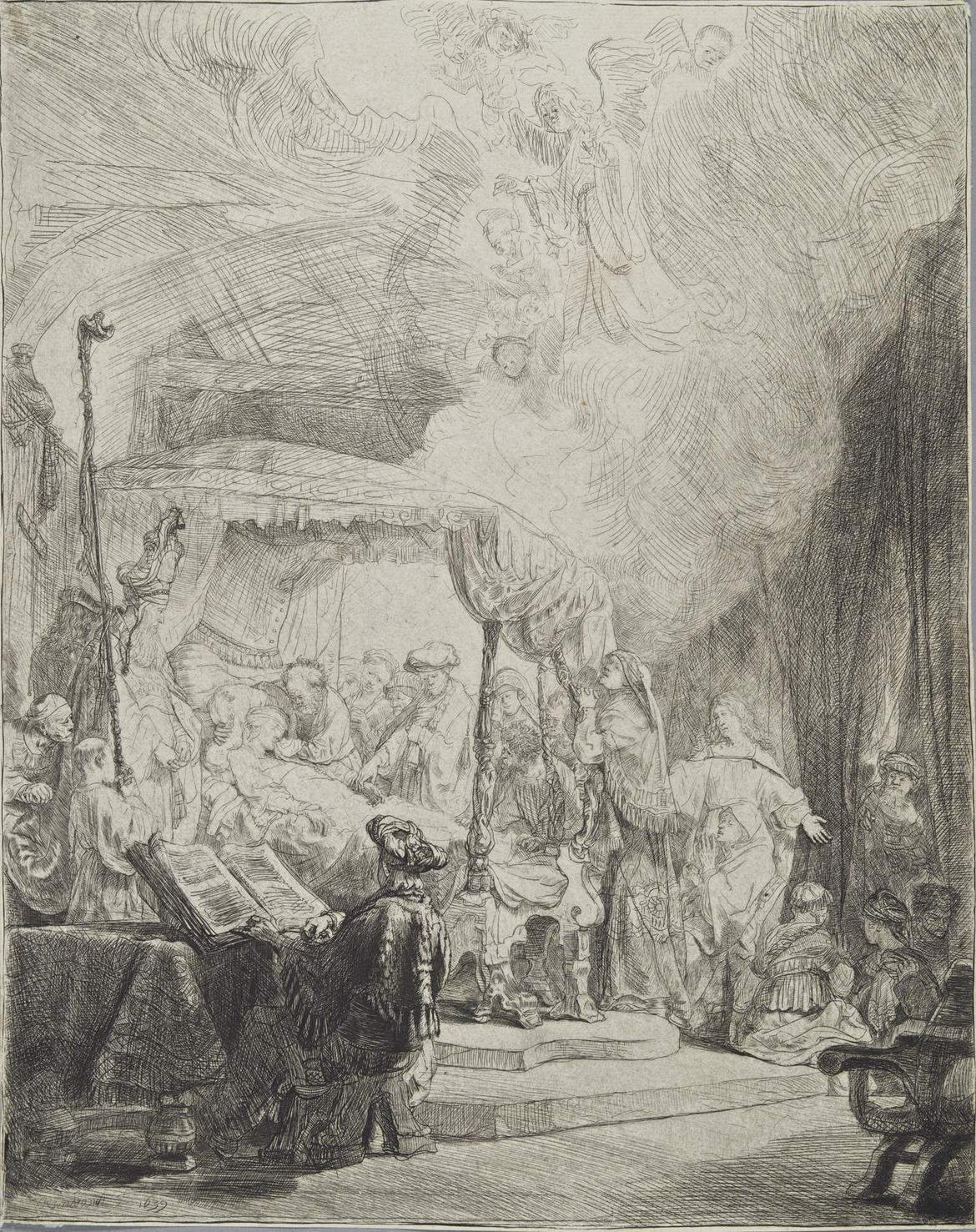An exhibition in Trento illustrates Rembrandt's graphic work through a Trentino collection
Castel Caldes, in the province of Trento, is hosting until Nov. 1 (it opened last July 21) an exhibition dedicated to a collection of engravings made by Rembrandt (Rembrandt van Rijn; Leiden, 1606 - Amsterdam, 1669), from the Lazzari Turco Menz collection, donated in 1924 to the Trento City Hall, and kept at the Buonconsiglio Castle.
The exhibition thus aims to illustrate the Dutch master’s graphic work: of the forty or so sheets in the museum’s collection related to the Dutch master, sixteen specimens are pulled from Rembrandt’s original plates and with watermarked papers that confirm their authenticity and dating, such as The Death of the Virgin or The Self-Portrait of 1633.
The exhibition thus aims to deepen the knowledge, fame, dissemination but also the fortune of the illustrious Dutch master, whose brilliant expressive power has left indelible and profound traces in the sphere of artistic history. “Riuscite molto belle, intagliate di buon gusto e fatte di buona maniera.” so Guercino in 1660 described with enthusiasm and admiration the etchings of the “great virtuoso” Rembrandt, expressing a judgment that would be shared by generations of artists, from Giovanni Benedetto Castiglione, to Stefano della Bella, to Piazzetta, to Piranesi, and that would fuel an extraordinary collecting passion, of which the Lazzari Turco Menz collection, one of the most eloquent episodes of private collecting, is undoubtedly a confirmation.
Formed by Karl Paul von Menz (Bolzano, 1778 - Milan, 1847), a member of a well-known Bolzano family, animators in the Atesine city of the lively musical season of the late eighteenth century, the collection of engravings, later inherited by Simone Turco Turcati (Trento, 1803 - 1861), has arrived at the Castello del Buonconsiglio in 1924, “assembled in various display cases or cardboard shelters,” thanks to the testamentary disposition of musician Raffaello Lazzari (Modena, 1845 - Trento, 1924), husband of Giulia Turco Turcati (Trento, 1848 - 1912), Simone’s daughter and great-granddaughter of Menz himself.
Consisting of just over a thousand folios, the collection includes, in addition to the printed specimens linked to Rembrandt’s name, exhibited here, a rich selection of works by authors from the Flemish-Dutch, German, French, Spanish and English areas, and among the most recurring names are those of Sadeler, Cort, Bloemaert, Bolswert, Vorsterman, Lucas van Leyden, Aldegrever, Dürer, Callot, Mellan, and Audran.
The exhibition focuses attention on some of the great themes favored by Rembrandt, among them the portrait, in which is reflected the intense and passionate study of the human soul with a highly original graphic writing executed, according to Filippo Baldinucci’s comment, with “certain friezes and frets, and irregular strokes and without dintel, making, however, from the whole a deep chiaroscuro and of great strength” (1681-1728).
A whimsical sign, loose and rapid, and strong shading, characterizesSelf-Portrait with Hat and Neck Scarf, whileSelf-Portrait with Saskia, which in thesetting recalls Raphael’s Portrait of Baldassar Castiglione, reveals the evocative power of the lesson of Sanzio, whose work Rembrandt was familiar with, through a series of translation prints contained in the so-called “prestige books” that belonged to the Leiden master’s personal collection.
An atmosphere of warm and silent intimacy is also breathed in the etching Three Women’s Heads of which One is asleep, dated 1637, in which the soft nuances, combined with a subtle and almost sketchy hatching, make one imagine an elaboration of the subject directly on the plate, like a small notebook, on which Rembrandt quickly outlines his impressions, grasping the mutability of emotional states. In the sheets devoted to the stories of theOld and New Testaments, the artist succeeds in capturing the dramatic essence of the episodes through strong chiaroscuro contrasts, particularly evident in Christ and the Samaritan Woman (1634) or Jesus Hunting the Merchants from the Temple (1635) in which the story, compressed within a dense weave of vigorous lines, is shot through with beams of light that burst into the scene with an extraordinary theatrical effect.
In the majestic stage layout of The Death of the Virgin (1639), inspired by Albrecht Dürer’s engraving of the same name, Rembrandt reaches one of his expressive heights: the choral participation of the characters, crowded around the bed, protected by a huge curtain, is described with a careful study of feelings, emotions and grief, emphasized by a decisive graphic mark and by the luminous glimpse that descends from above, abruptly, to indicate the solemnity of the event and with that particular manner “all made up of scrambled and replicated blows, with great force of dark” (Filippo Baldinucci).
The section devoted to translation prints derived from Rembrandt’s paintings, with works by Bernard Picart, Ferdinand Landerer, Christian Gottfried Schultze, Georg Friedrich Schmidt and Johannes Pieter de Frey, testifies to the great fortune encountered by the master and makes it possible to take a fascinating journey through the history of European graphic art, discovering the secrets of this complex artistic technique, which, as Francesco Milizia stated at the end of the 18th century, “by means of drawing and outlined and hollowed strokes on hard materials imitates the forms, shadows, and lights of visible objects and can multiply their imprints by means of impression.”
Admission to the castle and the exhibition is free.
For all information you can visit the official website of Trentino Cultura.
Pictured: Rembrandt, The Death of the Virgin (1639)
 |
| An exhibition in Trento illustrates Rembrandt's graphic work through a Trentino collection |
Warning: the translation into English of the original Italian article was created using automatic tools. We undertake to review all articles, but we do not guarantee the total absence of inaccuracies in the translation due to the program. You can find the original by clicking on the ITA button. If you find any mistake,please contact us.




























